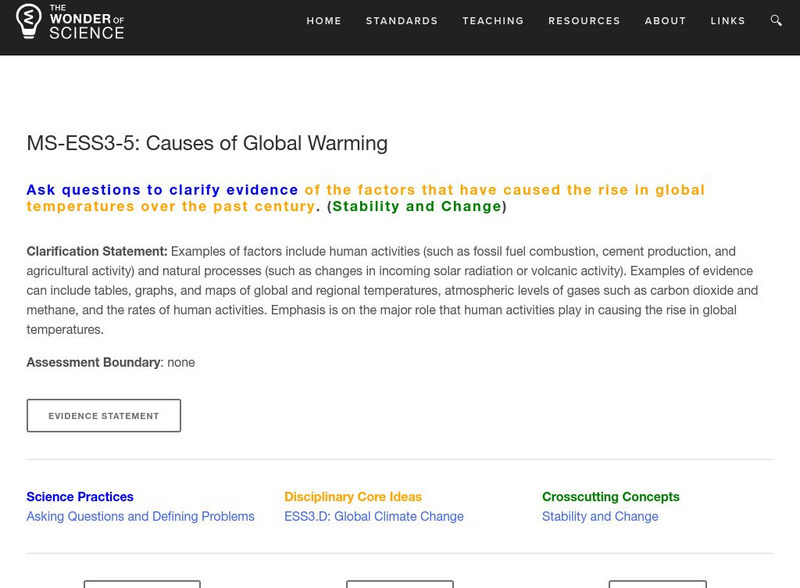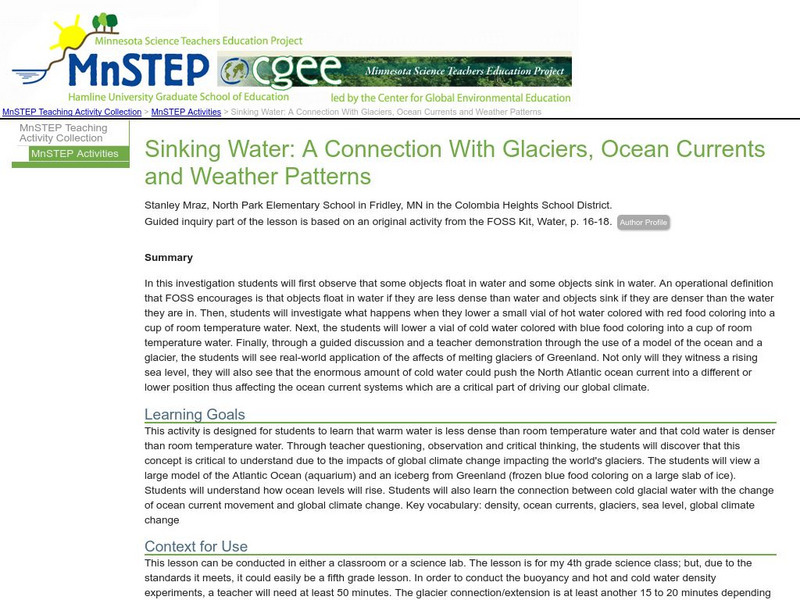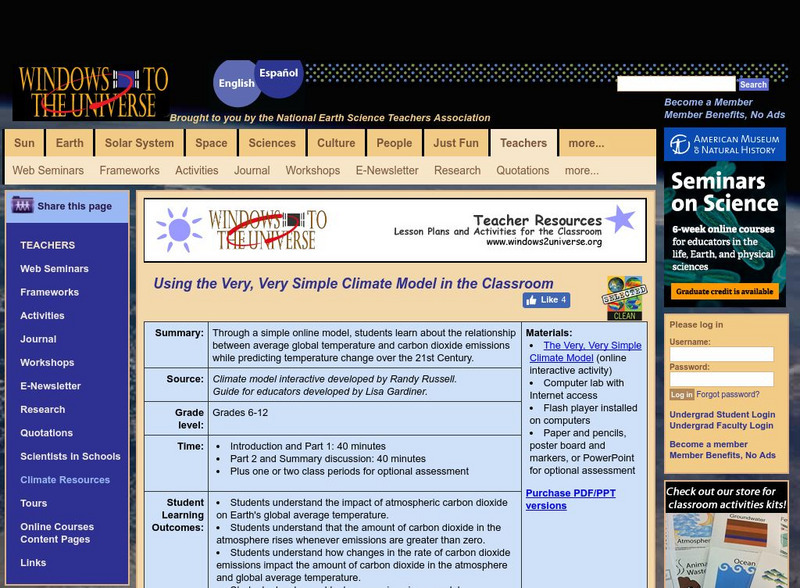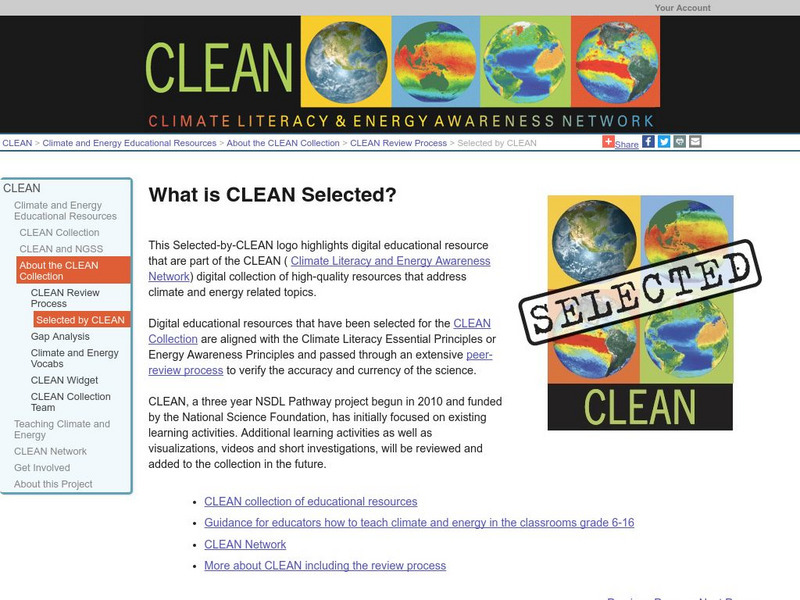PBS
Pbs Learning Media: Global Climate Change: The Effects of Global Warming
Students conduct an investigation to determine CO2 levels in four different gas samples, examine evidence of global warming in our environment, and consider their own role in contributing to global warming.
PBS
Pbs Learning Media: Global Climate Change: Understanding the Greenhouse Effect
Students study past climate change, explore the effect of greenhouse gases on Earth's atmosphere today, and consider human impact on global warming.
Climate Literacy
Clean: Global Warming Webquest
Students collaborate as part of a climate action team and learn how society and the environment might be impacted by global warming. Student teams investigate how and why climate is changing and how humans may have contributed to these...
The Wonder of Science
The Wonder of Science: Ms Ess3 5: Causes of Global Warming
Work samples, phenomena, assessment templates, and videos that directly address standard MS-ESS3-5: causes of global warming.
Climate Literacy
Clean: It's Time to Tell the Story About Buds, Leaves and Global Warming
In this activity, students explore how, in New England, the timing of color change and leaf drop of deciduous trees is changing.
TeachEngineering
Teach Engineering: Global Climate Change
Students learn how the greenhouse effect is related to global warming and how global warming impacts our planet, including global climate change. Extreme weather events, rising sea levels, and how we react to these changes are the main...
Other
Student Activities: Greenhouse Warming, What Is It? [Pdf]
This lesson plan resource contains a series of activities that allow the students to learn about the issue of global warming. Requires Adobe Reader. [PDF]
PBS
Pbs Teachers: Scientific American: Hot Times in Alaska: Light Absorption
Investigate the science behind global warming with these classroom activities. Compare light and dark objects to see how they respond to light absorption and heat generation, and describe the albedo values of various materials.
Smithsonian Institution
Smithsonian Learning Lab: Prehistoric Climate Change and Why It Matters Today
In a lesson in this issue of Smithsonian in Your Classroom, students do the work of a team of paleontologists studying a time of rising carbon dioxide and rapid global warming during the Eocene epoch. By examining fossils of tree leaves,...
NOAA
Noaa: Ocean Explorer: The Methane Circus
In this activity students will understand the events occuring during the Cambrian explosion. They will also begin to explain how methane hydrates contribute to global warming. Finally, they will discuss links between methane hydrates...
Science Education Resource Center at Carleton College
Serc: Mn Step: Sinking Water: Glaciers, Ocean Currents and Weather Patterns
A lesson where students learn how warm water is less dense than cold water, and what this means for global climate change as ice from the polar regions melts. Students will do experiments in buoyancy and water density when hot or cold,...
National Earth Science Teachers Association
Windows to the Universe: Using the Very Simple Climate Model in the Classroom
Through a simple online model, students learn about the relationship between average global temperature and carbon dioxide emissions while predicting temperature change over the next century.
PBS
Pbs Learning Media: Melting Ice
A mulit-media lesson where students explore the role that ice plays on Earth, the factors causing it to melt, and the local and global consequences of melting ice.
Science Education Resource Center at Carleton College
Serc: The Heat Is On: Understanding Local Climate Change
A lesson unit where students analyze long-term weather data for Phoenix to look for changes that have occurred over time. They look at factors that would cause climate warming, including greenhouse gases and other phenomena. They then...
Canadian Museum of Nature
Canadian Museum of Nature: Let's Do Science Programs
Site provides three lesson plans about global warming including one that discusses scenarios for future generations.
Annenberg Foundation
Annenberg Learner: The Habitable Planet: Energy Lab
Try and meet global energy demands by using alternative energy sources while keeping the carbon levels in the atmosphere down to acceptable levels. Simulator includes a data table available for download for student records.
TeachEngineering
Teach Engineering: Introduction to Environmental Engineering
Students are presented with examples of the types of problems that environmental engineers solve, specifically focusing on air and land quality issues. Air quality topics include air pollution sources, results of poor air quality...
Tramline
Tramline: Getting Green Virtual Field Trip
In this comprehensive website, students will learn about different forms of pollution, environmental impact of pollution, global warming, and things they can do to make a difference.
Climate Literacy
Clean: Introduction to Earth's Climate
This lesson plan is an introduction to Earth's climate and covers key principles regarding Earth's unique climate, atmosphere, and regional and temporal climate differences. Young scholars will gain an understanding of how the weather...
Science Education Resource Center at Carleton College
Serc: Exploring Regional Differences in Climate Change
Students create a set of graphs that facilitate comparison of climate change predicted for various states. They also use Microsoft Excel to create a graph showing precipitation data.
Climate Literacy
Clean: Public Service Announcement (Psa) for Grades 6 12
Students study climate change and create a Public Service Announcement that communicates their understanding of the science, raises awareness about climate change, and motivates people to take action.
Climate Literacy
Clean: How Does Melting Ice Affect Sea Level?
Students investigate how sea levels might rise when ice sheets and ice caps melt by constructing a pair of models and seeing the effects of ice melt in two different situations.
University Corporation for Atmospheric Research
Ucar: Project Learn: Where in the World Is Carbon Dioxide?
In this lesson on greenhouse gas, students conduct experiments to detect and collect carbon dioxide, then use titration to determine how much carbon dioxide is present in an indicator solution.
Climate Literacy
Clean: Climate Science Digital Resources
A digital collection of high-quality lesson resources that address climate and energy related topics.
Other popular searches
- Global Warming Worksheet
- Global Warming Recycling
- Global Warming Activities
- Global Warming Ozone
- Global Warming Projects
- Global Warming Labs
- Global Warming Lesson Plans
- Global Warming Affects
- Geography Global Warming
- Global Warming and Trees
- Environment Global Warming
- Global Warming Research

















